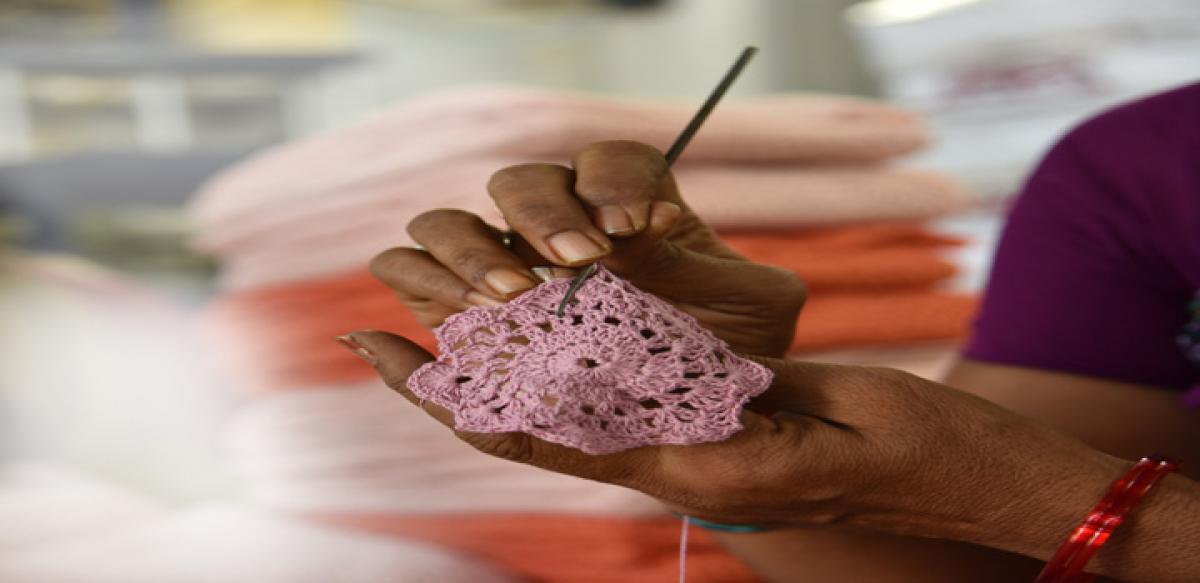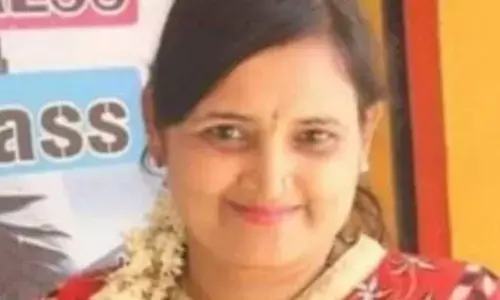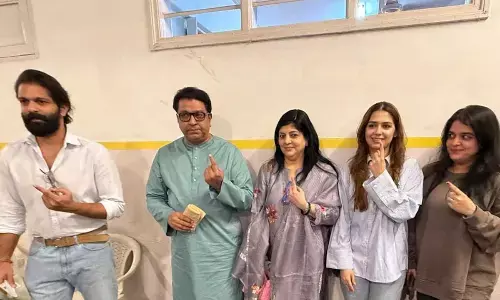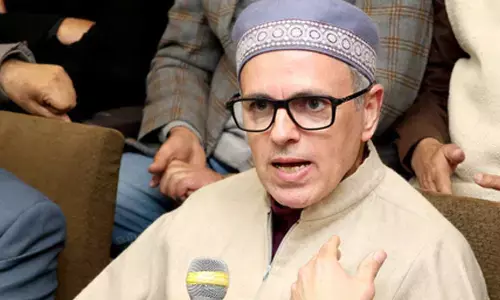Made in Narsapur

Amidst the lush green visages of Konaseema that make for the seemingly richest districts of Andhra Pradesh – with fertile lands producing three crops per year albeit subject to abundant rainfall, flourishing aqua culture and food industry thanks to the cashew, coconut and jaggery to name a few, lies a treasure of a craft that has been silently but surely making waves the world over.
Modiji’s ‘Make in India’ may be the new mantra for young India, but the export of lace and lace products made in Narsapur, West Godavari, that leverages on the ingenuous craft of crochet, exclusive to women belonging to Kapu community, has been an age-old industry passed on from one generation to another.
Even as the once flourishing export business has taken a major beating thanks to the downfall of global market – the more urgent problem at hand is the reluctance of the younger generation of crafts women to take up the low-paying work as a career. The world famous all-woman craft is on the verge of extinction, but for the timely intervention of the stake holders
Amidst the lush green visages of Konaseema that make for the seemingly richest districts of Andhra Pradesh – with fertile lands producing three crops per year albeit subject to abundant rainfall, flourishing aqua culture and food industry thanks to the cashew, coconut and jaggery to name a few, lies a treasure of a craft that has been silently but surely making waves the world over.
In a quaint town called Narsapur and the adjoining villages of West Godavari and a few in the East Godavari districts are the one lakh crafts women, the largest of such clusters existing in the country that spend their leisure time knitting exquisite lace in innumerable designs, much oblivious to the invaluable treasure of skill they possess.
And this is a traditional craft of crochet, handed down through generations of women to their daughters as naturally as they teach their daughters the fine art of handling the household. In one of the villages near Narsapur - Chinaseetapuram, in an area called Raavivarithota is a small house where women of a Self Help Group (SHG) assembled to knit together and talk about their work.
Here was an old lady who must be around her 70s comfortably knitting away the fine thread with the help of the two needles. She is Lakshmikantam whose husband was into agriculture and she has been knitting lace for as long as she can remember. She learnt it from her mother. “We used to earn from 25 to 50 paisa in those days. Today the times have changed and the rates have increased.
We make around Rs 150 to Rs 200 per half a kilo of reel,” she says. It is ingenious the way she does not even need glasses to help her see better, while several young ones opine that they have issues with eye sight and knee ache which is discouraging them to knit for long. “One has to eat dry fish to keep their eyes healthy,” she declares. The craft has been handed down to her daughter Rajeswari, who in turn taught her own daughter Anantha Sreekala.
On the sidelines of this exquisite craft that is nestled within deep Andhra Pradesh is also a flourishing export business, which is yet again a centuries old model that has stayed on to be taken up by generation after generation of exporter families. One such family of exporters is of Late Ramachandrudu, who started the export business several decades ago.
His sons, KN Tulasi and KV Swamy continued the business adding their touch by setting up factories and streamlining production. They actively participate in international fares and their recent tryst at Frankfurt resulted in huge orders from international brands like Homecentre. Their sons too entered the business recently and are taking it to the next level by employing digital technologies.
However, it is increasingly becoming difficult to fare well in the global competition especially from China that is able to produce lace at much cheaper rates, says Tulasi. On the home front, the money the women get after working on lace is very small and evidently the next generation will prefer to go for more profitable professions. He hopes government will chip in to improve the wages of the craftswoman. “Will the next generation take up the craft is a million dollar question,” he states.
The laces made in and around Narsapur travel all the way to Europe and the US. The exporters who make regular visits to the top most exporter meets abroad come back with newer ideas, better yarn (which is India made but from quality producers like Madhura Coats) and innovative designs in tune with the global market. The craftswomen recreate the most intricate of designs, which are used to produce lace products.
Even though there is domestic market for the laces, majority of the revenue for the laces comes from export. It is an interesting story behind how the craft came about. The area has predominantly families belonging to Kapu community, who think it is below their dignity to allow the women folk to go out and work. They apparently think it is also a way to protect women from conceived ills of the society.
And hence when the men go out to work in the fields, the women would finish their household chores and knit for a while. What started as a hobby attracted business men who understood the potential for Narsapur Lace in the international market. The money the women made was a pittance, yet good enough to assuage their sense of enterprise.
They would receive the order from line-men (the middle men) who would go around and distribute the yarn and give an order on behalf of the exporters. And even this at times is handled by the men folk in the family. The line men would then go around and collect the finished lace to be taken to the factory where the end products like table linen, bed spreads, western wear etc would be made. It was up to the line man to pay these women.
Since knitting lace is perceived to be just the so-called passing of time for the women, most in business thought and continue to think that a small price would suffice to pay the unorganised women, who anyway have never been serious about their work. The average money they would make per month was too miniscule to serve any purpose.
Someone is sick, they would stop working; some relative at home, there would be no work. In the absence of concentrated effort and lack of inspiration in terms of making money as livelihood, the output would be much too little than that is possible.
In the interim, a dynamic lady Hemalatha strived to bring together various SHGs under a co-operative in order to help in making lace artisans independent of middle-men. Her efforts gave way to Godavari Delta Women Lace Artisans Co-op Cottage Industrial Society Ltd. After her passing away the mantle of the Co-operative came over to her daughter Satya Sri.
In 2004, a Crochet Lace Park with the support of government that in addition to skill training, also tried bringing together various village-level co-operatives, providing a common centre to work and a marketing platform to them.
Be it the government intervention or natural rise in prices, there has been an increase in the amount paid to the crafts women; yet the modus operandi has remained more or less similar and Kapu women of the area end up making as less as Rs 15 to Rs 20 per day, that too if they are earnestly at work 7 – 8 hours a day.
On the other hand the export of lace too has taken a beating owing to global market crash and the entry of the Chinese lace which is consistent in quality and is available at much cheaper price. Exports have fallen over the last few years and the effect is felt by the home-bred craftswomen too, who now see much lesser work than in the last decade.
More importantly, none amongst the present generation is willing to teach the craft to their children. They would rather see their daughters well-educated and winning the corporate world than toil in the low-paid craft work.
“My granddaughter Grishma is going to school. Why will she even do this,” Rajeswari sounds incredulous about even the mention. In such a scenario, came the EPCH that has with it successful models of promoting exports at craft pockets in Moradabad, Jodhpur, Kutch, Srinagar and has set up Mega clusters at these places. Rakesh Kumar, Executive Director shares, “The exports from India are currently at Rs 30,000 crores including handicrafts and carpets (Rs 10,000 crore) of which only 5 to 6 per cent is from south India.
This includes the wooden craft from Mahabalipuram, agarbatti, which is now a more organised sector, a bit of Bidri and Narsapur Lace. With over one lakh skilled Lace artisans, we need to create the demand and this we plan to do through our skill development and market development initiatives.”
“The Export Promotion Council for Handicrafts has under its wing over 900 exporters and we have been making efforts to sponsor them to the best of the international B2B exhibitions. Recently, we took lace exporters from Narsapur to Frankfurt, one of the most expensive international exhibitions and the response has been very good,” he adds.
In addition to providing skill training to young women in a bid to bring in the next generation into the Crochet fold, EPCH has also set NOS (National Occupational Standards) for Lace work and has begun issuing Level 1 certificates to the eligible trainees, who are being fine tuned at the craft and also enterprising individuals who are being trained at EDP.
The latter can either work for the existing exporters or become entrepreneurs. EPCH has also set up 55 Community Development Centres in various locations in the two Godavari districts that are used to impart training and as a common facility to work for women. Doing crochet for a stipulated time everyday together under a watchful eye would lead to better and consistent results and the craft will then cease to be just a part time work.
“We are convincing the woman craft persons on the need for training to achieve international standards and we are convincing them to step out of their house for training and subsequent work. Till date, we have trained around 3,250 women and we shall reach 5,000 this month,” Rakesh Kumar relates.
Even as many traditional craftswomen and exporters continue to have reservations on the effectiveness of the model; the path for change has been laid. During a recently held Reverse Buyer Seller Meet at the newly built International Lace Trade Centre one saw many young women who expressed their happiness over how their craft has fine tuned thanks to the training.
There were also other new entrants like members of ‘Make In India – My Village Consortium’, who have gained enough confidence to test the turf. The women entrepreneurs received EDP training from EPCH and are all set to take on the lace market, face on.
Here is a vibrant craft that has already created a world market ages ago. It is now time to build upon the existing market and make it a competitive product in the international sphere. In an interaction with Dr Gopal, Development Commissioner (Handicrafts) at the Trade Centre, various exporters who had come to check the products from across India shared similar sentiment.
It is a testing time for the craft as the craftswomen are increasingly opting for jobs in other spheres like the Cashew industry, which pays more for less hours of work and the exporters are struggling with onslaught of China lace among other worries. It is imperative to find a middle path that will ensure minimum wage to the artisan,
who at present is getting ridiculously low payment when compared to the ingenuous craft they possess; reduce the cost of raw material without affecting the quality of the product and add value to the crochet products to appeal to global consumers. Facilities like dying of yarn at the trade centre and engaging premier design institutes for design support are being planned by EPCH.
Going by the response of the exporters, the other very important factors to be considered for export promotion include improved connectivity to Narsapur that will have a direct impact on the cost and introducing incentives and subsidies on export.
On a positive note, the wheel has been set on roll –there is the intent of the government to make Narsapur a vibrant export hub, there is the younger generation bursting with energy and innovative ideas to take the traditional craft forward, the co-operatives are doing their bit in getting their members trained so as to improve the standard of their product and the exporters are working doubly hard to employ technology to create the best of the designs to make an impact in the world market. Yet the challenges remain.

















